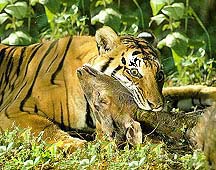-
The roar of a Bengal tiger can be heard 2 miles away.
-
Bengal tigers purr. Domestic cats purr when breathing in as well as out, Tigers only purr while breathing out.
-
After killing its prey, the tiger always starts feeding from the hindquarters first.
-
A tiger is a voracious eater. It can kill the equivalent of 30 buffaloes a year, and eat 65 pounds of meat in a night.
-
Tigers, unlike many other cats, often eat meat that has begun to putrefy.
-
The Siberian tiger, a cousin of the Bengal tiger, is the worlds largest cat.

ORDER: Carnivora
FAMILY: Felidae
GENUS & SPECIES: Panthera tigris tigris
 Bengal's
Habitat
Bengal's
Habitat
The Bengal tiger is most numerous in the mangrove forest of the Sundarbans in eastern India and Bangladesh where the River Ganges meets the Bay of Bengal. They are also found in other areas of India as well as some parts of Nepal and Burma.
Since Bengal tigers are solitary and do not like to share their hunting grounds, they need large home ranges in which to hunt. Males occupy about 20 square miles, while females typically require 17 square miles. A tiger usually has several dens in its home range and uses whichever one is most convenient at the time.
 Bengal's
Behavior
Bengal's
Behavior
The Bengal tiger is solitary and does not like to share its range with other tigers. All tigers mark their territory with strong-smelling urine and also by shedding the bark of trees.
Bengal tigers drag the remains of a kill into the brush and bury it loosely with leaves, then return to eat it later.
 Bengal's
Breeding
Bengal's
Breeding
Bengal tigers usually breed in the spring. A neighboring male will mate with a female in her home range. Of the 20-80 days he remains with her, she is fertile for only 3-7 days. After mating, the male returns to his home range and plays no part in rearing the cubs.
Approximately 15 weeks later, the tigress gives birth to two to four cubs. She suckles them for 8 weeks, after which she brings them prey to eat as well. At 11 months, the cubs can hunt on their own. The tiger cubs stay with their mother for 2-3 years, at which time she is ready to mate again.
 Food
& Hunting
Food
& Hunting
Bengal tigers are nocturnal: they hunt at night. Though powerful and quick over short distances, they stalk their prey because they cannot outrun faster prey. The tiger kills small prey with a bite on the back or the neck and large prey with a bite to the throat.
Tigers mainly hunt gaur (wild ox) and buffalo. Although a tiger is capable of killing a bull gaur more then twice its size, it prefers to attack younger or old animals that put up less resistance.
In the Sundarbans region of India and Bangladesh, the tiger's prey are chital (axis deer), wild boar, and monkeys. Tigers will sometimes attack porcupines.
 DID
YOU KNOW?
DID
YOU KNOW?
Key Facts!
Sizes
LENGTH: Males, 9-10ft., head to tip of tail.
SHOULDER HEIGHT: 36in.
WEIGHT: Male 400-575Ib.
Breeding
SEXUAL MATURITY: 3-4 years.
MATING: Usually in spring.
GESTATION: 95-112 days.
LITTER SIZE: 2-4 cubs.
Lifestyle
HABIT: Solitary and nocturnal
DIET: Chital, wild boar, monkeys, gaur, buffalo.
CALL: Roar, growl, or purr.
LIFESPAN: 15 years under normal conditions.
Related Species
There are seven other sub-species of tiger in the world. The color of the coat distinguishes one sub-species from another.

(Ouch! that's got to hurt!)

¤ Home ¤ Bengal Tiger Fact Sheet ¤ Siberian Tiger Fact Sheet ¤ Picture Page #1 ¤ Picture Page #2 ¤ Picture Page #3 ¤
¤ Link Page ¤ Personal Link Page ¤ Banner Page ¤ Awards Page ¤
All information found on this page was borrowed from MCMXCI IMP BV/IMP INC. WILDLIFE FACT FILE: Card #5 Labeled Bengal Tiger